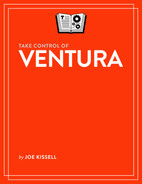Explore Other App Improvements
The previous chapter, Discover Other System Improvements, reviewed changes in Ventura that affected the entire system or multiple apps. In this final chapter, I walk you through some of the most interesting changes to specific apps.
Once again, I cover these in alphabetical order, not in order of importance.
Clock
Although Macs have always had built-in clocks (you can see the current time on your main menu bar, and you can configure the clock’s appearance by going to System Settings > Control Center and clicking Clock Options), what’s new in Ventura is a standalone Clock app just like the one we’ve had in iOS and iPadOS since, if memory serves, the late 1930s.
By default, Clock opens to a World Clock view (Figure 52); you can also click the tabs at the top to set alarms, use a stopwatch, or start a countdown timer. Am I going to cover every one of those features in detail? I am not. Because, I mean, it’s a clock. It’s pretty much self-explanatory, and if you’ve ever used the Clock app in iOS/iPadOS, or any of the innumerable real-world equivalents, you’ve got this.

I will, however, briefly mention that because this app exists, Ventura now gets some new capabilities by extension:
Siri actions: Siri can now set timers and alarms, just as in iOS/iPadOS, and you can ask Siri what time it is in Saskatoon (it’s 8:50 A.M.) or another city.
New Shortcuts actions: The Shortcuts app gains new clock-related actions, just like the ones it already had on those other platforms.
FaceTime
FaceTime gets a few new features in Ventura, of which the first is particularly interesting:
Handoff support: Handoff is the technology that has, for years, let you start a thing on one Apple device and pick it up seamlessly on another—for example, viewing a map in Maps or a webpage in Safari. To hand off from an iPhone or iPad to a Mac, just look for the special Dock icon on the Mac representing the app you have open on your iPhone, click it, and you’re in. (Handoff must be enabled on your Mac in System Settings > General > AirDrop & Handoff, and on your iOS/iPadOS devices in Settings > General > AirDrop & Handoff.) Now Ventura offers Handoff support for FaceTime calls too.
The user interface for handing off a FaceTime call is slightly different. If you start a FaceTime call on your iPhone or iPad, and want to continue it on your Mac, click the FaceTime
 icon on your menu bar, and in the banner that appears (Figure 53), click Switch.
icon on your menu bar, and in the banner that appears (Figure 53), click Switch.
Figure 53: Use this button to switch a FaceTime call to your Mac. When FaceTime opens on your Mac, click Join. If you were using AirPods or another Bluetooth headset, the audio transitions to your Mac as well. (And, of course, you can also do the reverse—start a FaceTime call on your Mac and continue it on an iPhone or iPad.)
Collaboration: Most built-in Apple apps (such as Notes, Pages, and Safari) and some third-party apps support collaboration, in which multiple people can view or work on the same thing. What’s new in Ventura is that if you click a collaborator’s icon on the toolbar of one of these apps, the popover that appears (Figure 54) now has icons that let you start an audio or video FaceTime call with that person.
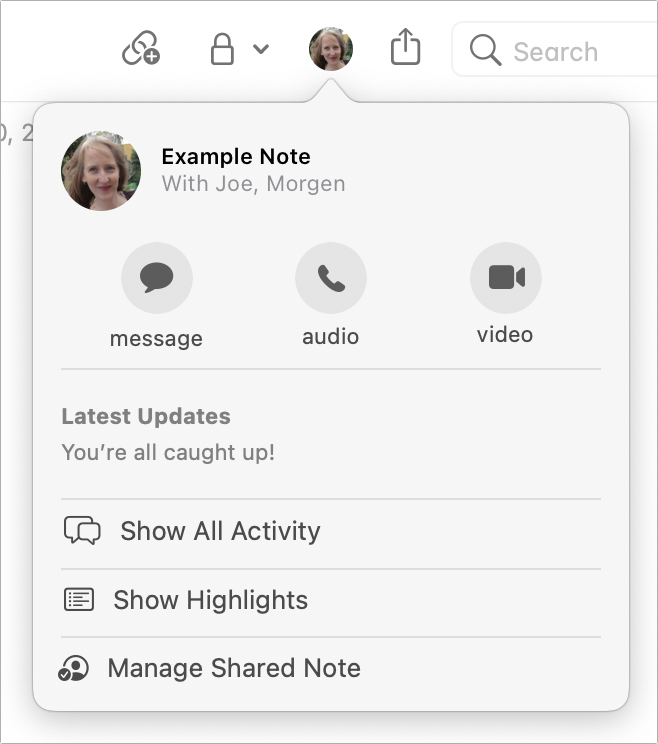
Figure 54: Click a collaborator’s avatar on the toolbar to see collaboration activity—including new audio and video icons to start FaceTime calls. In-app Live Captions: Get a live transcript of what everyone on your call is saying; see Live Captions.
Freeform
Freeform is the name of a new app, which appeared in macOS 13.1, the first major update to Ventura. It’s a virtual whiteboard (Figure 55), somewhat like a simplified version of OmniGraffle—a blank canvas on which you can draw; add images, audio, documents, and web links; and collaborate in real time with colleagues or friends (including support for SharePlay in FaceTime calls).

The drawing and annotation tools are similar to those in other Apple software (Markup, Preview, Notes), and you can add collaborators—who can brainstorm with you with each person’s changes shown in real time—using the Share ![]() menu.
menu.
For complete instructions, consult Apple’s Freeform User Guide.
Home
The Home app, used to manage smart devices and home automation based on Apple’s HomeKit technology, has been redesigned with a new look and feel, as well as new features. I wish I could show them all to you in detail, but as the total inventory of HomeKit-compatible devices in use at my house is two Apple TVs and a HomePod mini, so I don’t have much to work with.
Still, here’s a quick overview:
New Home tab: The Home tab of the Home app now features a tile for each room of your house.
Updated tiles: Tiles for accessories have a new visual design for easier recognition, and can be controlled by clicking the tile.
Categories in sidebar: The revised sidebar now includes categories for whatever devices you have (such as Lights, Climate, and Speakers and TVs).
Multi-camera view: If you have HomeKit-compatible home security cameras, up to nine of them appear on the Home tab, and you can scroll to see more. (Also, if you have more than nine security cameras in your house, seriously, are you kidding me?)
In addition, Apple says that, in an update to Ventura later this year, two additional changes will occur:
Updated architecture: An updated version of Home will feature an internal redesign that’s faster, more reliable, and more efficient.
Matter support: Apple has joined forces with other smart-home developers to create a cross-platform standard called Matter, which should enable compatibility with a greater range of devices.
Maps
The Maps app has two new features:
Multi-stop directions: You can now plan a driving route that includes multiple destinations—great for long, multi-day road trips or moving across the country. To do this, get directions to your first stop, as usual. Then, in the directions overlay, click Add Stop, select your next destination, and continue as needed (Figure 56). Your multi-stop directions also sync to your iPhone automatically.
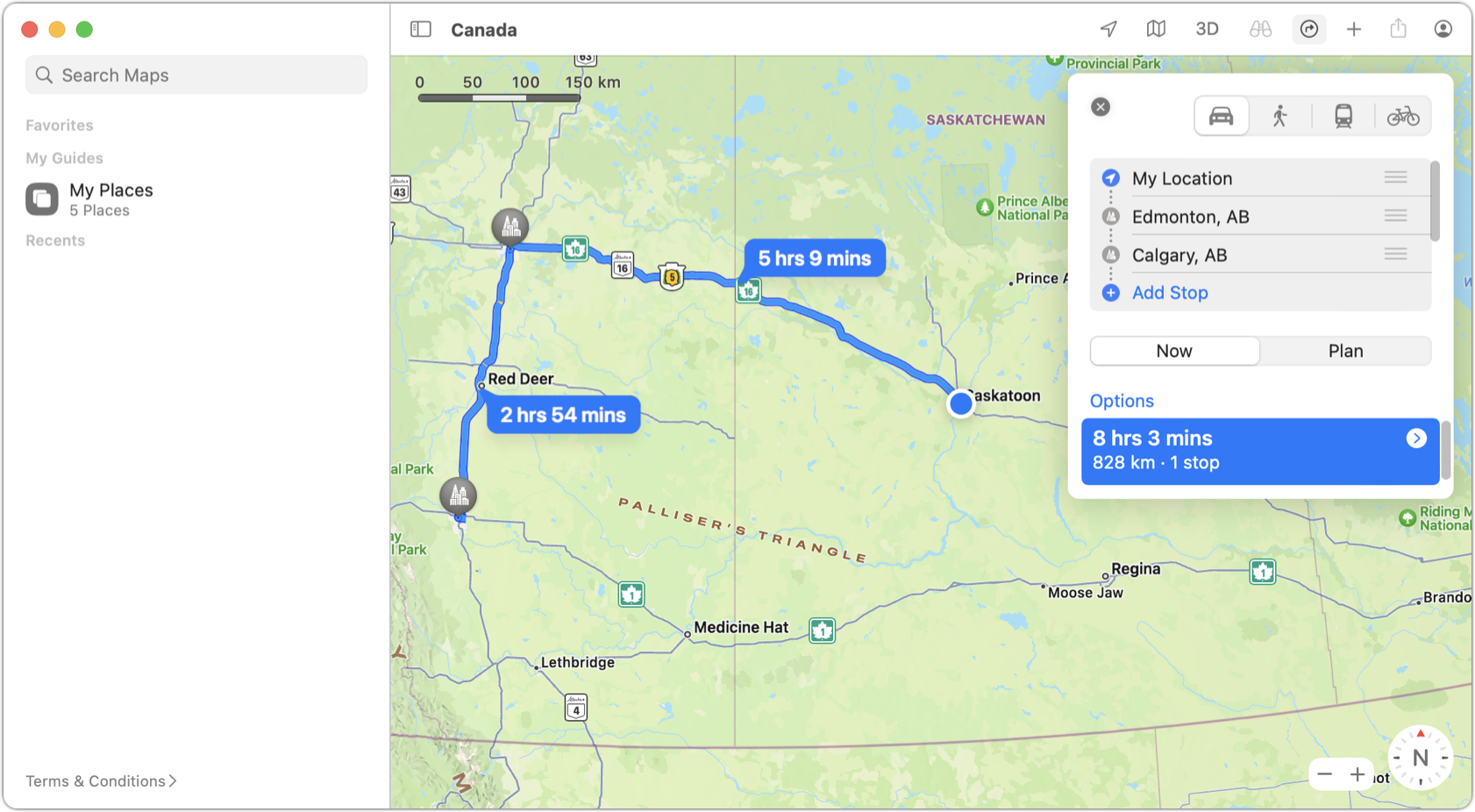
Figure 56: Too much driving for one day? Maps can show you a longer route with intermediate stops. Transit fares: When getting directions by public transit, some routes show fares. Support for this feature varies by city, transit company, and route.
Music
The only significant new feature Apple mentions for Music is favorite artists. To designate an artist as one of your favorites, go to any album, playlist, mix, or song where the artist’s name is shown in the main view. Click the name to bring up the artist’s page, and then click the favorite ![]() icon, which then fills in
icon, which then fills in ![]() (color may vary depending on the background). Afterward—and note that it may take some time—a new Favorite Artists row appears near the bottom of the Listen Now view.
(color may vary depending on the background). Afterward—and note that it may take some time—a new Favorite Artists row appears near the bottom of the Listen Now view.
Apple says that, as a result of the favorite artists, you’ll get “new music notifications and improved recommendations,” but I have yet to see what that looks like in practice.
News
The News app has a few changes:
Favorites: The sidebar in the News app now has a Favorites category, which appears to list frequently read periodicals. To add a publication as a favorite, first make sure you’re following it—right-click or Control-click an article and choose Publication Name > Follow Channel from the contextual menu. Then, right-click or Control-click the publication in the sidebar and choose Add to Favorites from the contextual menu. To remove a favorite from this list, Control-click (or right-click) it and choose Remove from Favorites from the contextual menu.
Newspaper home pages: If you select the channel for a newspaper, you may see a pop-up menu on the toolbar listing the paper’s sections; a new item in this menu, Home, takes you to a special News home page for the publication. (Not all newspapers offer the pop-up menu with sections, let alone a home page.)
My Sports: A new My Sports section in the Today view lets you follow sports teams and athletes, getting all sorts of detailed extra information about them in one place. Moreover, all your settings here sync across your Apple devices. To set this up, click Get Started in the My Sports section and click Turn On, or go to News > Settings and check Sync My Sports. (At first I couldn’t find this feature; it took me a while to realize it was because I had blocked literally every sports-related channel and topic News showed. Now that I’ve found it, I’m blocking them all again.)
Apple says News in Ventura will also feature local news in more markets, but without any list of what those new markets are, I’m unable to offer any more details about that.
Notes
From the simplest of beginnings, Notes continues to evolve into a powerhouse app for writing as well as collecting and organizing information. Ventura adds even more useful features to Notes.
The recently added features are:
New filters for smart folders: In Monterey, smart folders in Notes could match only tags. In Ventura, they can also match Date Created, Date Modified, Shared, Mentions, Checklists, Attachments, Folders, Quick Notes, Pinned Notes, and Locked Notes. As before, you create a smart folder by choosing File > New Smart Folder.
Filter by any or all: When creating a smart folder, you can add multiple criteria (as described above). You can also choose Any or All from a pop-up menu above those criteria to make your matches more flexible. Similarly, if you select one or more tags in the tag browser in the sidebar, a pop-up menu lets you choose Any Selected or All Selected. A similar feature appears in Reminders.
Lock with login password: Encrypting notes with a password is not new, but Ventura now offers you the option to use your Mac’s login password to lock and unlock all your notes, rather than creating a separate password for each one. Although unique passwords are more secure, using your login password gives you one less thing to remember, and gives you one less hoop to jump through when locking notes.
The first time you lock a note in Ventura (File > Lock Note), Notes asks whether you want to use your login password or a separate password. Click Use Login Password or Create Password, as you prefer.
Date groups in sidebar: In the Notes sidebar and in the gallery view (View > as Gallery), your notes are now grouped in reverse chronological order by date—Today, Yesterday, Previous 7 Days, Previous 30 Days, then by month for the previous year and by year thereafter. (The Today smart list in Reminders offers a similar feature.)
Collaboration changes: Notes already offered a collaboration option, which lets you add one or more people to a note. All participants can see each others’ changes in real time. In Ventura, the interface for adding collaborators has changed a bit, and Apple now lets you open up collaboration to anyone who has the link (rather than restricting it to specific invitees), if you prefer.
To add a collaborator:
Click the Share
 icon and make sure Collaborate is showing in the pop-up menu.
icon and make sure Collaborate is showing in the pop-up menu.Click “Only people you invite can edit.”
From the first pop-up menu under Permissions, choose either “Only people you invite” (the default choice) or “Anyone with the link” (the new option).
From the second pop-up menu, choose “Can make changes” or “View only.”
If you want to prevent invitees from extending the invitation to still other people, uncheck “Allow others to invite.”
Select a destination (one or more people, or a sharing method).
Reminders
The humble Reminders app, where you may keep your to-do and shopping lists, gets quite a few new features in Ventura (as well as in iOS 16/iPadOS 16).
Here’s what’s new or different in Ventura:
Pinned lists: If you have lots of lists and you want to keep your favorites at the top where they’re easy to find, you can now pin them. Select a list and choose File > Pin List.
Notifications for shared lists: Apple calls this a feature, but I found it to be an annoyance. By default, whenever someone with whom you’re sharing a list adds something to the list, you get a notification. I didn’t like being beeped every time my wife added milk to our shopping list (OK, we drink a lot of milk here). To turn this off, click the shared list
 icon on the toolbar, click Manage Shared List, and uncheck Adding Reminders. (Optionally check Completing Reminders if you want to know when your spouse has bought that milk.) Click Done.
icon on the toolbar, click Manage Shared List, and uncheck Adding Reminders. (Optionally check Completing Reminders if you want to know when your spouse has bought that milk.) Click Done.Completed smart list: A new smart list in the sidebar, Completed, lets you view all completed reminders across all your lists at once. Even better, if you want to delete many or all 1,397 of those items, you can now do so with three clicks: while viewing the Completed smart list, click the Clear link; then choose Older Than a Month, Older Than 6 Months, Older Than a Year, or All Completed from the pop-up menu; and click Delete to confirm.
Updated Today and Scheduled smart lists: The Today smart list is now organized by Morning, Afternoon, and Tonight; while the Scheduled list has reminders for today, followed by items grouped by week and month.
Templates: If you find yourself frequently making similar lists for fleeting events (for example, packing lists for trips), you can now create a template, which is simply a reusable list that serves as a starting point for a new list. To do this, create a list with whatever default items you want, then choose File > Save as Template, give the template a name, and click Create. To later create a new list based on that template, choose File > New List, click Templates, select your template, and click Create List. You can then add, remove, or edit items on your new list as usual, without having to reenter every item from scratch.
Styled text in notes: Text in the Notes field of a reminder can now include styles like bold, italic, and underline. Use the usual keyboard shortcuts or Control-click/right-click selected text and choose an attribute from the Font submenu of the contextual menu.
Combined list groups: If you have a list group (which you can create by choosing File > New Group, and then dragging lists into it), you can now select the group’s icon in the sidebar to display a view that combines the constituent lists and their reminders.
Filter by any or all: When creating a smart list, you can already add multiple criteria (to match tags, dates, priorities, and so on). Now, as in Notes, you can choose Any or All from a pop-up menu above those criteria to make your matches more flexible. Similarly, if you select one or more tags in the tag browser in the sidebar, a pop-up menu lets you choose Any Selected or All Selected.
Shortcuts
The Shortcuts app in Ventura looks and acts almost the same as the version in Monterey. However, there were a few noteworthy improvements:
New actions for Books, Clock, Reminders, and Safari, and updates to existing actions for Calendar and Clock
A new Get Current Focus action, as well as Focus Filter actions for certain apps
A Search in Shortcuts action
Updates to the Get Battery State, Get Current Weather, and Send Email actions
A new Show in Share Sheet option (previously available only in iOS/iPadOS)
App Shortcuts—prebuilt, single-action shortcuts bundled with certain App Store apps
Changes to the process for sharing shortcuts
Various other small user interface changes
Stocks
I’ve always thought the Stocks app was a curiosity in both iOS/iPadOS and macOS—unlike nearly all the other built-in apps, it’s not designed for the average consumer, but rather for a very specific type of person—someone who regularly buys and sells individual stocks and other securities. (I’ve never bought or sold stocks myself, and as far as I’m aware, I don’t even know anyone who has. Am I just weird?)
If you, however, are the sort of person who pays careful attention to stocks—and if you use the Stocks app to do so—you may want to know about the following changes:
Upcoming earnings dates: If the annual earnings report for a selected stock is scheduled for the near future, the date appears above the graph (Figure 57). You can click Add to Calendar to remind yourself.

Figure 57: This stock has an upcoming earnings report (date highlighted in green). Multiple watchlists: In the Monterey version of Stocks, the sidebar showed your (single) watchlist. In Ventura, you can create more than one. I’ll just point you to the various commands on the File menu and leave it at that.
Two-column widget options: If you add a Stocks widget to Notification Center, you’ll notice that the medium and large widget options now have a two-column layout.
Tips
Since Monterey, macOS has had a built-in app called Tips that—you guessed it—shows you tips on how to use your Mac, and more specifically the newest macOS features. The odd thing about this app is that you can’t open it manually. Every once in a while—assuming you have notifications enabled for the Tips app, as they are by default, an alert like Figure 58 pops up.

You can click the notification to open the Tips app (Figure 59). From there you can browse tips as you like, or use the search field to find information about something specific. But, if you were to locate this app in the Finder (spoiler: it’s hidden in /System/Library/CoreServices) and double-click it, nothing would happen. So far, I have found no way to open this app on demand—not use Spotlight or Siri or any other method I know. So, if you want to browse the tips on your own schedule, you’re out of luck! Better jump on that notification when it appears.
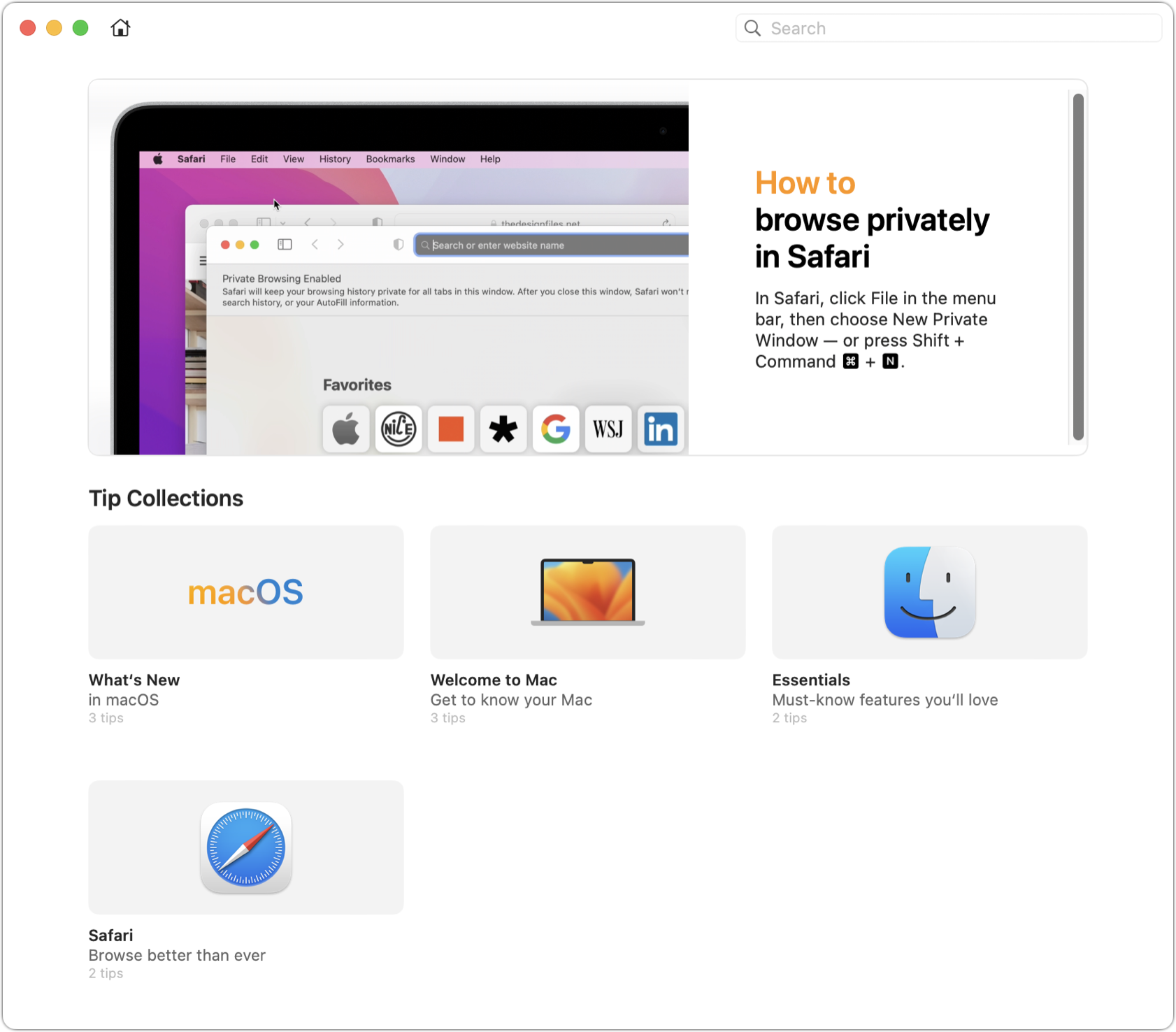
Ventura adds Tip Collections (shown above in Figure 59), which group tips thematically. That’s super nice, I guess, but would it be asking too much to be able to look at tips when I want to, rather than just when Apple wants me to?
Weather
Along with the Clock app, Weather (Figure 60) has now made the transition from iOS/iPadOS to macOS. The Mac version of Weather closely resembles the iPadOS 16 version.
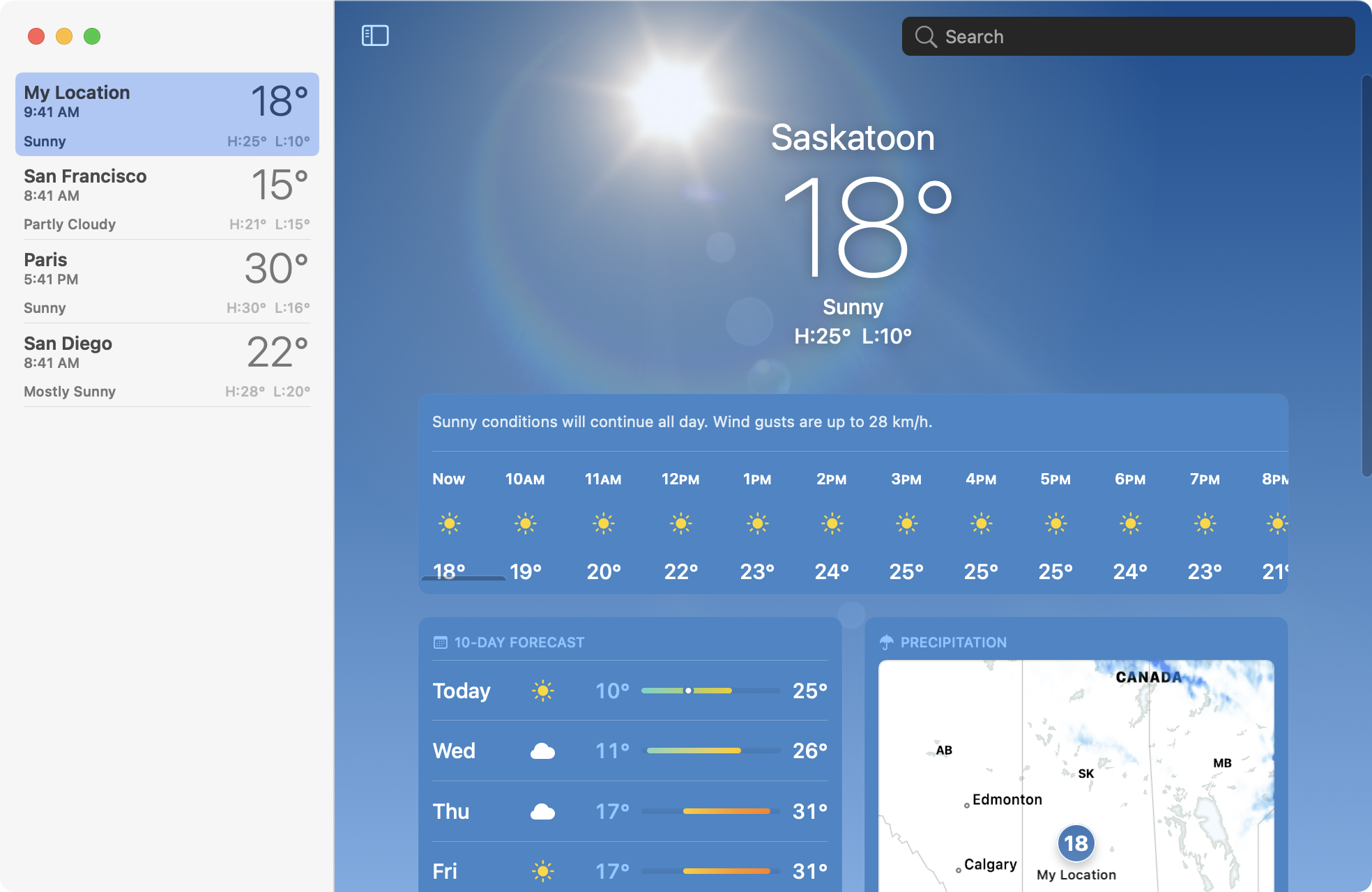
Like the Clock app, Weather is mostly self-explanatory. A few tips:
Click for details: Click any tile for more details. If you click a specific day in the 10-day forecast, you’ll get details for that day. Tap the precipitation map for an animated 12-hour forecast of precipitation; you can zoom in and out or drag to show anywhere in the world.
More map options: While viewing the map, you can click the Layers
 icon and choose Precipitation, Temperature, or Air Quality from the pop-up menu to show that element on the map.
icon and choose Precipitation, Temperature, or Air Quality from the pop-up menu to show that element on the map.Add a city: If you want to add a location to the list of favorites in the sidebar, use the Search field at the top to find a city, then click the Add button at the top of the window.
Notifications: To receive notifications on your Mac for severe weather alerts and/or precipitation within the next hour, go to Weather > Settings and check the appropriate boxes for your current location (or other favorite locations).
